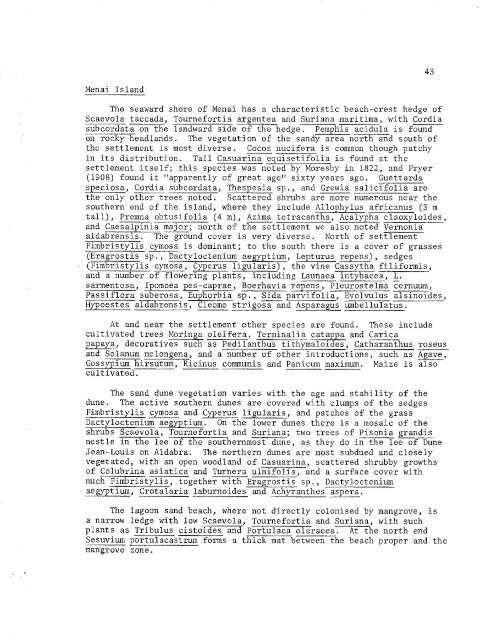ATOLL RESEARCH BULLETIN - Smithsonian Institution
ATOLL RESEARCH BULLETIN - Smithsonian Institution
ATOLL RESEARCH BULLETIN - Smithsonian Institution
Create successful ePaper yourself
Turn your PDF publications into a flip-book with our unique Google optimized e-Paper software.
Menai Island<br />
The seaward shore of Menai has a characteristic beach-crest hedge of<br />
Scaevola taccada, Tournefortia argentea and Suriana maritima, with Cordia<br />
--<br />
subcordata on the landward side of the hedge. Pemphis acidula is found<br />
on rocky headlands. The vegetation of the sandy area north and south of<br />
the settlement is most diverse. Cocos nucifera is common though patchy<br />
in its distribution. Tall Casuarina equisetifolia is found at the<br />
settlement itself; this species was noted by Moresby in 1822, and Fryer<br />
(1908) found it "apparently of great age" sixty years ago. Guettarda<br />
speciosa, Cordia subcordata, Thespesia sp., and Grewia salicifolia are<br />
the only other trees noted. Scattered shrubs are more numerous near the<br />
southern end of the i.sland, where they include Allophylus africanus (3 m<br />
tall), Premna obtusifolia (4 m), Azima tetracantha, Acalypha claoxyloides,<br />
and Caesalpinia major; north of the settlement we also noted Vernonia<br />
--<br />
aldabrensis. The ground cover is very diverse. North of settlement<br />
Fimbristylis - cymosa is dominant; to the south there is a cover of grasses<br />
(Eragrostis sp., Dactyloctenium aegyptium, Lepturus repens), sedges<br />
(Fimbristylis - cymosa, Cyperus ligularis), the vine Cassytha filiformis,<br />
and a number of flowering plants, including Launaea intybacea, L.<br />
sarmentosa, Ipomoea -- pes-caprae, Boerhavia repens, Pleurostelma cernuum,<br />
Passiflora suberosa, Euphorbia ~p.,~arvifolia, -<br />
Evolvulus alsinoides,<br />
Hypoestes aldabrensis, Cleome strigosa and Asparagus umbellulatus.<br />
At and near the settlement other species are found. These include<br />
cultivated trees Moringa oleifera, Terminalia catappa and Carica<br />
papaya, decoratives such as Pedilanthus tithymaloides, Catharanthus roseus<br />
and Solanum melongena, and a number of other introductions, such as Agave,<br />
Gossypium hirsutum, Ricinus communis and Panicum maximum. Maize is also<br />
-<br />
cultivated.<br />
The sand dune vegetation varies with the age and stability of the<br />
dune. The active southern dunes are covered with clumps of the sedges<br />
Fimbristylis cymosa and Cyperus ligularis, and patches of the grass<br />
Dactyloctenium aegyptim. On the lower dunes there is a mosaic of the<br />
shrubs Scaevola, Tournefortia and Suriana; two trees of Pisonia grandis<br />
nestle in the lee of the southernmost dune, as they do in the lee of Dune<br />
Jean-Louis on Aldabra. The northern dunes are most subdued and closely<br />
vegetated, with an open woodland of Casuarina, scattered shrubby growths<br />
of Colubrina asiatica and Turnera ulmifolia, and a surface cover with<br />
much Fimbristylis, together with Eragrostis sp., Dactyloctenium<br />
aegyptium, Crotalaria laburnoides and Achyranthes aspera.<br />
The lagoon sand beach, where not directly colonised bv manprove. " ~. ~, is --<br />
a narrow ledge with low Scaevola, ~ournefortia and ~uriana; with such<br />
plants as Tribulus cistoides and Portulaca oleraceay At the north end<br />
Sesuvium portulacastrum forms a thick mat between the beach proper and the<br />
mangrove zone.<br />
43

















